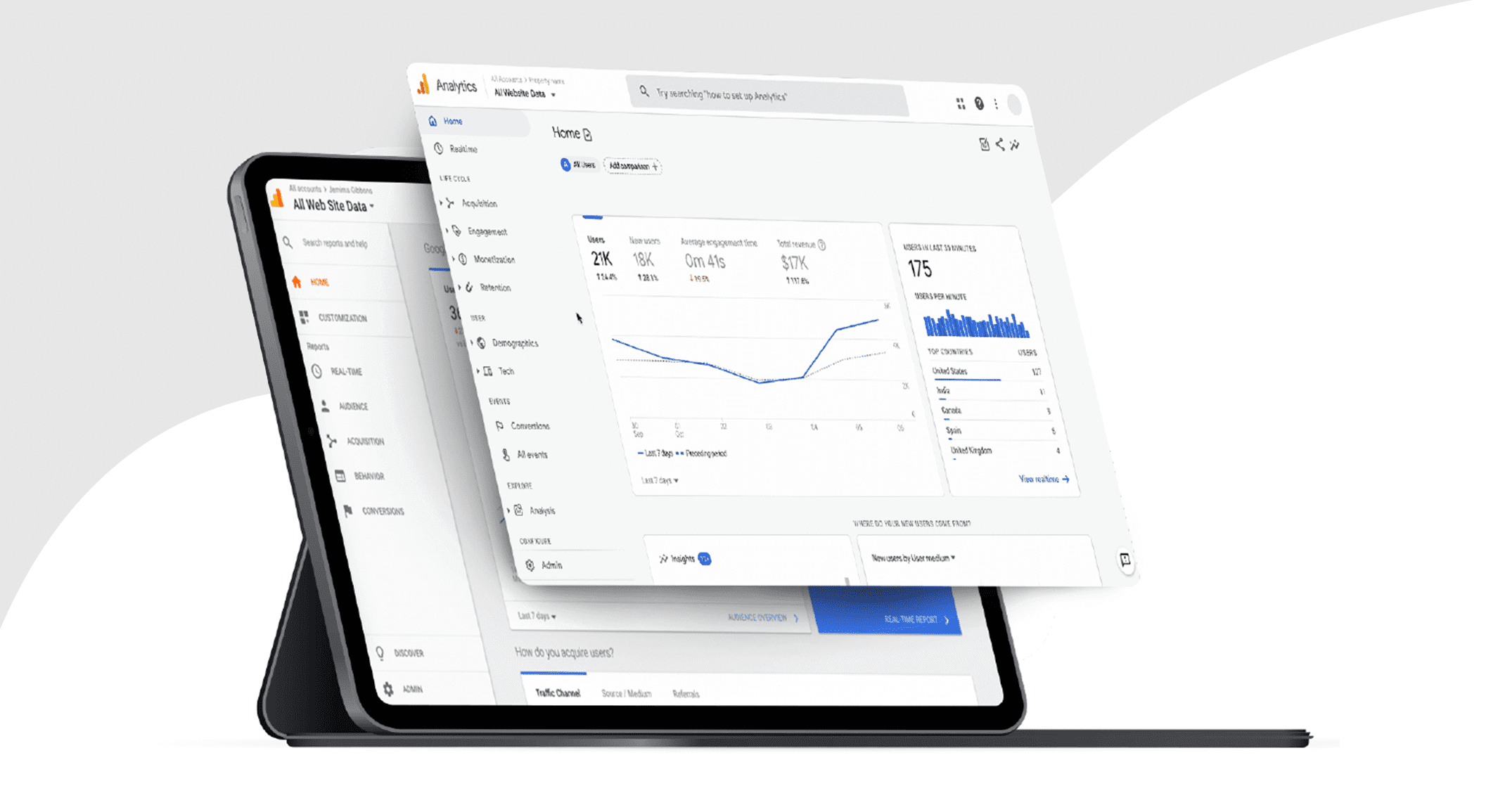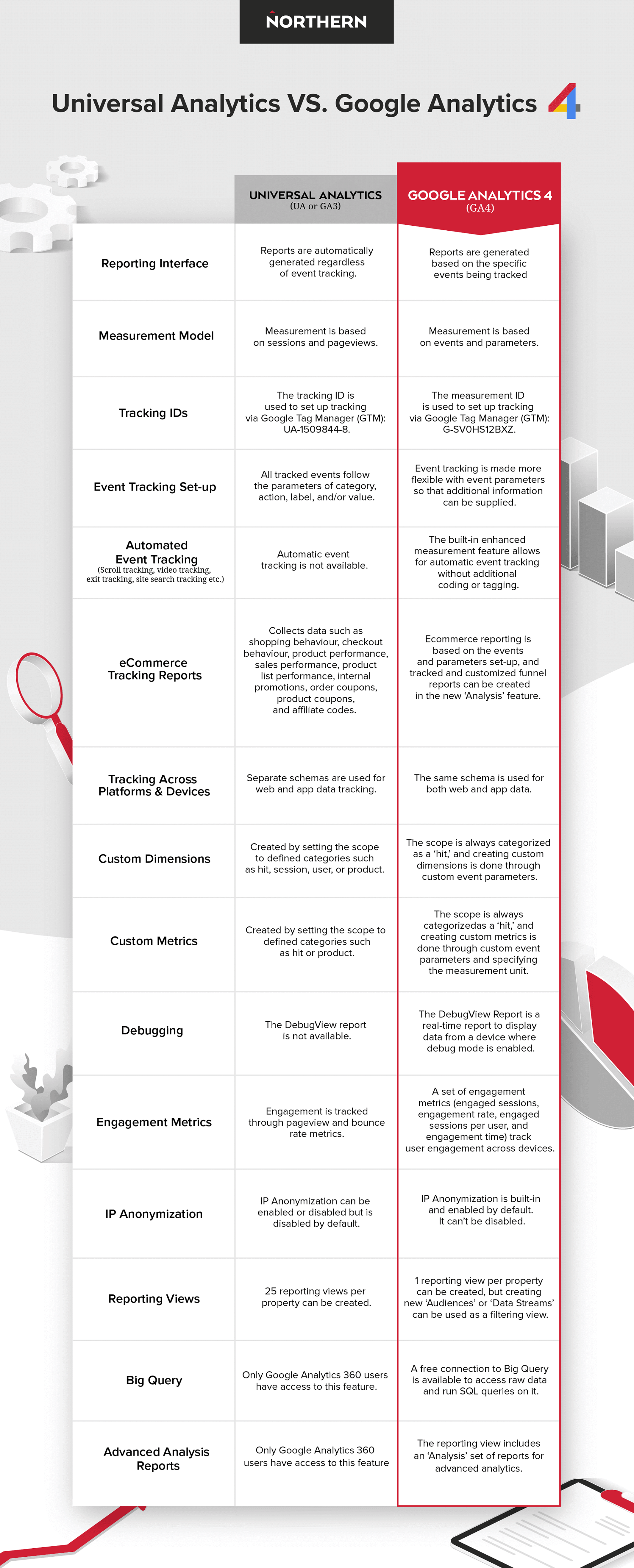The Benefits of Using Google Analytics 4
Google Analytics 4 provides a robust and forward-thinking solution to providing an effective omni-channel experience, accurately tracking the customer journey, and optimizing conversions. Building on the foundation of Google’s former App + Web property introduced in 2019, Google Analytics 4 was designed for better ROI outcomes. Generating customized insights led by machine learning, it’s the puzzle piece that will provide big-picture information across all devices and platforms.
Why choose Google Analytics 4?
For the first time, the Google Analytics 4 property merges your customer’s website journey with their mobile app experience. You get the full spectrum of data and insights needed to make informed marketing decisions and understand your customer’s entire lifecycle. This level of integration and flexibility is not possible with Google’s Universal Analytics.
By making the switch to Google Analytics 4, you’ll be harnessing advanced machine learning models’ power to gain richer consumer insights, discover significant data trends, and tap into powerful predictive metrics.
Google Analytics 4 vs. Universal Analytics
While Google Analytics 4 is relatively new on the scene, there are already some significant differences between it and Google’s Universal Analytics. At first glance, the reporting interface serves up a different set of reports than you may be used to seeing, but it’s all in the name of a customized reporting experience. Reports are generated based on the events that are being tracked, ensuring you see the metrics that relate directly to the conversions and behaviours that have the most impact.
Take a look at our Universal Analytics vs Google Analytics 4 chart below, where we’ve broken down the most significant updates and new features.
Embed this on your site:
<!– Copy and Paste This Code Into Your Post –>
<br />
<h3>The Benefits of Using Google Analytics 4</h3>
<br />
<a href=”https://www.northern.co/benefits-using-google-analytics-4/”><img src=”https://www.northern.co/wp-content/uploads/NC-UA-v-GA4-1.png” alt=”The Benefits of Using Google Analytics 4″ width=”100%” /></a>
Why switch to Google Analytics 4?
Gain Deeper Insights Into The Customer Journey
One of the biggest game-changers in Google Analytics 4 is that it brings the customer journey full circle. The ability to track events across platforms and devices lets you see the whole picture for the first time. The new event-driven data model places a user-focused lens on your data allowing you to track engagement and events with a single set of metrics and dimensions.
Even the menus got a facelift to align with this outlook. Say goodbye to the Audience, Acquisition, Behaviour, and Conversion menus. Now the ‘Lifecycle’ section separates data analysis into Acquisition, Engagement, Monetization, and Retention. This follows the customer journey and lines up with organizational marketing goals. It enables you to optimize the end-to-end shopping journey and target user drop-off, engagement, and conversion touchpoints. When you can leverage data in this way, it’s clear when marketing goals are achieved. This contributes to reaching overall organizational objectives by adding measurable value and success.
TOP TIP: To unlock the full capabilities of these features, your app and web environments must be correctly configured by developers to create and capture a custom User ID.
Discover What Really Engages Customers
The closest thing we have to knowing what our customers are thinking is to pay attention to what engages them. Sometimes a metric like Bounce Rate isn’t enough to infer user intent–various external factors could prompt a person to leave a page. This is why Google Analytics 4 has rolled out a superior array of engagement metrics, including:
- Engaged Sessions
- Engagement Rate
- Engaged Sessions per User
- Engagement Time
These metrics will allow more granular analysis and can be partnered with the new pre-configured enhanced measurement features. Which are automatically tracked events for behaviours such as:
- Scroll Tracking
- Video Tracking
- Exit Tracking
- Site Search Tracking
These tools create opportunities for maximizing and utilizing engagement like never before. Evaluating data with a user-first approach makes you capable of efficiently delivering content your audience actually wants while informing your strategy. Believe it or not, the AI used in these metrics is so powerful it can even predict a customer’s action and value–more on that in the next section.
TOP TIP: To get used to the new engagement metrics try setting target Engagement Rates for your channels and campaigns. As a rule of thumb take the inverse of what your Bounce Rate was in Universal Analytics. For example, if your Bounce Rate was 63% set a target Engagement Rate of 37%. Feel free to adjust as you become more familiar with the data.
Be Prepared For What’s Next
The future is now! The tools Google Analytics 4 has introduced will function as staples in marketing and data analysis tomorrow. This does not mean abandoning all previous methods, but this signals a shift in how we will start analyzing and using data to adjust to customer behaviours and desires. The new customer-centric metrics and dimensions seem to be the tip of the iceberg when it comes to predictive analytics. Implementing a Google Analytics 4 property now ensures enough time for configuration, aggregating data, leveraging the free integrations (Ad Words and BigQuery), and laying the groundwork for future success. No one wants to be playing catch-up a year from now.
The evolving technology landscape will likely expand predictive analytics’s abilities to continue improving ROI and marketing opportunities. Currently, Google Analytics 4 can predict churn and purchase probability. Google has stated predictive metrics like potential revenue are on the way. This creates the potential to tailor audiences to reach higher-value customers. These are the types of opportunities you can prepare to benefit from in the near future.
TOP TIP: To fully take advantage of predictive metrics, Google Analytics 4 needs at least 28 days of data and 1000 positive and negative outcomes, for these models to produce predictions. In addition, the correct events and parameters must be configured to gather the relevant data.
Considering Google Analytics 4?
Transitioning to Google Analytics 4 may sound like a large undertaking, but if you only take away one bite of information, it’s this–cookies. That’s right, the text files containing small pieces of data referred to as cookies soon will be less common. This matters because cookies track users and provide valuable information on their behaviour and habits, which is used to direct relevant content to the appropriate audiences.
The world is becoming cookie-less due to browsers reimagining the future of privacy online and directives like the GDPR enhancing privacy and consent laws. Organizations need to adapt to evolving trends and regulations; otherwise, their marketing efforts and strategies will fall short. Establishing a property now on Google Analytics 4 will bridge the gap when this shift occurs.
If you want Google Analytics 4 to drive results for you, contact Northern today, our eCommerce professionals can take you from configuration to conversions!
Stay informed, sign up for our newsletter.



